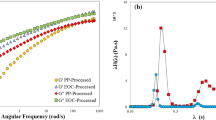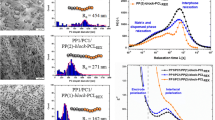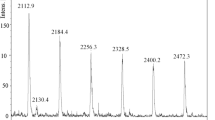Abstract
Dynamic viscoelastic measurements were combined with differential scanning calorimetry (DSC) and atomic force microscopy (AFM) analysis to investigate the rheology, phase structure, and morphology of poly(l-lactide) (PLLA), poly(ε-caprolactone) (PCL), poly(d,l-lactide) (PDLLA) with molar composition l-LA/d-LA = 53:47, and poly(l-lactide-co-ε-caprolactone) (PLAcoCL) with molar composition l-LA/CL = 67:33. After melt conformation, both copolymers PDLLA and PLAcoCL were found to be amorphous whereas PLLA and PCL presented partial crystallinity. The copolymers and PCL were considered as thermorheologically simple according to the rheological methods employed. Therefore, data from different temperatures could be overlapped by a simple horizontal shift (a T) on elastic modulus, G′, and loss modulus, G′, versus frequency graph, generating the corresponding master curves. Moreover, these master curves showed a dependency of G″≈ω and G′≈ω 2 at low frequencies, which is a characteristic of homogeneous melts. For the first time, fundamental viscoelastic parameters, such as entanglement modulus G N 0 and reptation time τ d, of a PLAcoCL copolymer were obtained and correlated to chain microstructure. PLLA, by contrast, was unexpectedly revealed as a thermorheologically complex liquid according to the failure observed in the superposition of the phase angle (δ) versus the complex modulus (G*); this result suggests that the narrow window for rheological measurements, chosen to be close to the melting point centered at 180 °C thus avoiding thermal degradation, was not sufficient to assure an homogeneous behavior of PLLA melts. The understanding of the melt rheology related to the chain microstructural aspects will help in the understanding of the complex phase structures present in medical devices.








Similar content being viewed by others
References
Andreopoulos AG, Hatzi E, Doxastakis M (1999) Synthesis and properties of poly(lactic acid). J Mater Sci Mater Med 10:29–33
Bates FS (1984) Block copolymers near the microphase separation transition. 2. Linear dynamic mechanical properties. Macromolecules 17:2607–2613
Bird RB, Armstrong RC, Hassager O (1977) Dynamics of polymeric liquids, vol. 1: fluid mechanics. Wiley, New York.
Booij HC, Palmen JHM (1982) Some aspects of linear and nonlinear viscoelastic behavior of polymer melts in shear. Rheol Acta 21:376–387
Booij HC, Palmen JHM (1992) Linear viscoelastic properties of a miscible polymer blend system. Theor Appl Rheol Proc Int Congr Rheol 11(1):321–323
Chuang HK, Han CD (1984) Rheological behavior of polymer blends. J Appl Polym Sci 29:2205–2229
Cohn D, Salomon AH (2005) Designing biodegradable multiblock PCL/PLA thermoplastic elastomers. Biomaterials 26:2297–2305
Cooper-White JJ, Mackay ME (1999) Rheological properties of poly(lactides). Effect of molecular weight and temperature on the viscoelasticity of poly(l-lactic acid). J Polym Sci, Part B: Polym Phys 37:1803–1814
Crescenzi V, Manzini G, Calzolari G, Borri C (1972) Thermodynamics of fusion of poly-β-propiolactone and poly-ε-caprolactone. Comparative analysis of the melting of aliphatic polylactone and polyester chains. Eur Polym J 8:449–463
De Santis P, Kovacs AJ (1968) Molecular conformation of poly(S-lactic acid). Biopolymers 6:299–306
Dorgan JR, Williams JS, Lewis DN (1999) Melt rheology of poly(lactic acid): entanglement and chain architecture effects. J Rheol 43:1141–1155
Dorgan JR, Janzen J, Clayton MP, Hait SB, Knauss DM (2005) Melt rheology of variable l-content poly(lactic acid). J Rheol 49:607–619
Eckstein A, Suhm J et al (1998) Determination of plateau moduli and entanglement molecular weights of isotactic, syndiotactic, and atactic polypropylenes synthesized with metallocene catalysts. Macromolecules 31:1335–1340
Es-Haghi SS, Yousefi AA, Oromiehie A (2007) Thermorheological complexity of poly(methyl methacrylate)/poly(vinylidene fluoride) miscible polymer blend: terminal and segmental levels. J Polym Sci, Part B: Polym Phys 45:2860–2870
Fernández J, Etxeberria A, Sarasua J (2012) Synthesis, structure and properties of poly(l-lactide-co-epsilon-caprolactone) statistical copolymers. J Mech Behav Biomed Mater 9:100–112
Ferry JD (1980) Viscoelastic properties of polymers, 3rd edn.
Fetters LJ, Lohse DJ, Richter D, Witten TA, Zirkel A (1994) Connection between polymer molecular weight, density, chain dimensions, and melt viscoelastic properties. Macromolecules 27:4639–4647
Florez S, Munoz A, Santamaria ME (2006) Novel dynamic viscoelastic measurements of polyurethane copolymer melts and their implication to tack results. Macromol Mater Eng 291:1194–1200
Garkhal K, Verma S, Jonnalagadda S, Kumar N (2007) Fast degradable poly(l-lactide-co-ε-caprolactone) microspheres for tissue engineering: synthesis, characterization, and degradation behavior. J Polym Sci, Part A: Polym Chem 45:2755–2764
Graessley WW (2008) Polymeric liquids and networks dynamics and rheology.
Gurp MV, Palmen J (1998) Time-temperature superposition for polymeric blends. 67:5
Han CD, Lem KW (1983) Temperature-independent correlation of elastic responses of viscoelastic liquids. Polym Eng Rev 2:135–165
Herbert IR (1993) Statistical analysis of copolymer sequence distribution. In: Ibbet RN (ed) Physical properties of synthetic high polymers. Blackie Academic & Professional, London, pp 50–79
Hiljanen-Vainio M, Karjalainen T, Seppälä J (1996) Biodegradable lactone copolymers. I. Characterization and mechanical behavior of ε-caprolactone and lactide copolymers. J Appl Polym Sci 59:1281–1288
Huang SJ (2005) Poly(lactic acid) and copolyesters. In: Bastioli C (ed) Handbook of biodegradable polymers. Rapra Technology Ltd, Shawbury, pp 287–301
Izu P, Munoz ME, Pena JJ, Santamaria A (1994) Viscoelastic measurements on main-chain thermotropics. Polymer 35:2422–2427
Jacobs C, Dubois P, Jerome R, Teyssie P (1991) Macromolecular engineering of polylactones and polylactides. 5. Synthesis and characterization of diblock copolymers based on poly-ε-caprolactone and poly(l,l or d,l)lactide by aluminum alkoxides. Macromolecules 24:3027–3034
Jeong SI, Kim B et al (2004a) In vivo biocompatibility and degradation behavior of elastic poly(l-lactide-co-epsilon-caprolactone) scaffolds. Biomaterials 25:5939–5946
Jeong SI, Kim B, Lee YM, Ihn KJ, Kim SH, Kim YH (2004b) Morphology of elastic poly(l-lactide-co-ε-caprolactone) copolymers and in vitro and in vivo degradation behavior of their scaffolds. Biomacromolecules 5:1303–1309
Jeong SI, Kim SH et al (2004c) Manufacture of elastic biodegradable PLCL scaffolds for mechano-active vascular tissue engineering. J Biomater Sci Polym Ed 15:645–660
Jone MU, Sarasua JR (2011) Effect of aging on mechanical behavior of a biodegradable poly(lactide-caprolactone) copolymer. Ann Tech Conf Soc Plastics Eng 69:1964–1968
Kapnistos M, Hinrichs A, Vlassopoulos D, Anastasiadis SH, Stammer A, Wolf BA (1996) Rheology of a lower critical solution temperature binary polymer blend in the homogeneous, phase-separated, and transitional regimes. Macromolecules 29:7155–7163
Kasperczyk J, Bero M (1991) Coordination polymerization of lactides. 2. Microstructure determination of poly[(l,l-lactide)-co-(ε-caprolactone)] with carbon-13 nuclear magnetic resonance spectroscopy. Makromol Chem 192:1777–1787
Kharas GB, Sanchez-Riera F, Severson DK (1994) Polymers of lactic acid. In: Mobley DP (ed) Plastics from microbes. Hanser, New York, pp 93–137
Kricheldorf HR (2001) Syntheses and application of polylactides. Chemosphere 43:49–54
Kricheldorf HR, Kreiser-Saunders I (1996) Polylactides—synthesis, characterization and medical application. Macromol Symp 103:85–102
Majeste J-C, Santamaria A (2011) Rheology and viscoelasticity of multiphase polymer systems: blends and block copolymers. In: Boudenne A et al. (eds) Handbook of multiphase polymer systems. Wiley. pp 311-357
Mavridis H, Shroff RN (1992) Temperature dependence of polyolefin melt rheology. Polym Eng Sci 32:1778–1791
Meaurio E, Zuza E, Sarasua JR (2005) Miscibility and specific interactions in blends of poly(l-lactide) with poly(vinylphenol). Macromolecules 38:1207–1215
Michell RM, Muller AJ, Castelletto V, Hamley I, Deshayes G, Dubois P (2009) Effect of sequence distribution on the morphology, crystallization, melting, and biodegradation of poly(ε-caprolactone-co-ε-caprolactam) copolymers. Macromolecules 42:6671–6681
Miyata T, Masuko T (1998) Crystallization behaviour of poly(l-lactide). Polymer 39:5515–5521
Nalampang K, Molloy R, Punyodom W (2007) Synthesis and characterization of poly(l-lactide-co-ε-caprolactone) copolymers: influence of sequential monomer addition on chain microstructure. Polym Adv Technol 18:240–248
Neumann C, Loveday DR, Abetz V, Stadler R (1998) Morphology, dynamic mechanical properties, and phase behavior of ABC-triblock copolymers with two semicompatible elastomer blocks. Macromolecules 31:2493–2500
Noroozi N, Thomson JA, Noroozi N, Schafer LL, Hatzikiriakos SG (2012) Viscoelastic behaviour and flow instabilities of biodegradable poly(epsilon-caprolactone) polyesters. Rheol Acta 51:179–192
Othman N, Acosta-Ramirez A, Mehrkhodavandi P, Dorgan JR, Hatzikiriakos SG (2011) Solution and melt viscoelastic properties of controlled microstructure poly(lactide). J Rheol 55:987–1005
Othman N, Jazrawi B, Mehrkhodavandi P, Hatzikiriakos SG (2012) Wall slip and melt fracture of poly(lactides). Rheol Acta 51:357–369
Palade L, Lehermeier HJ, Dorgan JR (2001) Melt rheology of high l-content poly(lactic acid). Macromolecules 34:1384–1390
Pathak JA, Van Gurp M (2000) Rheology of a miscible blend of SAN and SMA. J Appl Polym Sci 78:1245–1249
Perego G, Vercellio T, Balbontin G (1993) Copolymers of l- and d,l-lactide with 6-caprolactone: synthesis and characterization. Macromol Chem Phys 194:2463–2469
Plazek DJ (1996) 1995 Bingham medal address: Oh, thermorheological simplicity, wherefore art thou? J Rheol 40:987–1014
Ramkumar DHS, Bhattacharya M (1998) Steady hear dynamic properties of biodegradable polyesters. Polym Eng Sci 38:1426–1435
Rojo E, Pena B, Munoz ME, Santamaria A (2006) A study of the use of oscillatory flow to characterize isotactic and syndiotactic poly(propylene)s. Macromol Chem Phys 207:1781–1788
Sarasua JR, Prud’homme RE, Wisniewski M, Le Borgne A, Spassky N (1998) Crystallization and melting behavior of polylactides. Macromolecules 31:3895–3905
Schwarzl F, Staverman A (1952) Time-temperature dependence of linear viscoelastic behavior. JAppl Phys 23:838–843
Shen Y, Zhu KJ, Shen Z, Yao K (1996) Synthesis and characterization of highly random copolymer of ε-caprolactone and d,l-lactide using rare earth catalyst. J Polym Sci, Part A: Polym Chem 34:1799–1805
Södergård A, Stolt M (2002) Properties of lactic acid based polymers and their correlation with composition. Prog Polym Sci 27:1123–1163
Song CX, Feng XD (1984) Synthesis of ABA triblock copolymers of Îμ-caprolactone and dl-lactide. Macromolecules 17:2764–2767
Trinkle S, Walter P, Friedrich C (2002) Van Gurp-Palmen plot II—classification of long chain branched polymers by their topology. Rheol Acta 41:103–113
Urayama H, Kanamori T, Kimura Y (2001) Microstructure and thermomechanical properties of glassy polylactides with different optical purity of the lactate units. Macromol Mater Eng 286:705–713
Vasanthakumari R, Pennings AJ (1983) Crystallization kinetics of poly(l-lactic acid). Polymer 24:175–178
Williams CK (2007) Synthesis of functionalized biodegradable polyesters. Chem Soc Rev 36:1573–1580
Wu S (1989) Chain structure and entanglement. J Polym Sci, Part B: Polym Phys 27:723–741
Wu S (1992) Predicting chain conformation and entanglement of polymers from chemical structure. Polym Eng Sci 32:823–830
Zarraga A, Pena JJ, Munoz ME, Santamaria A (2000) Thermorheological analysis of PVC blends. J Polym Sci, Part B: Polym Phys 38:469–477
Acknowledgments
The authors are grateful for funds of the Basque Government (GV/EJ) Department of Education, Universities and Research for project GIC10/152-IT-334-10 and for predoctoral grant of J. M. U., MICINN for project BIO2010-21542-C02-01, and the University of the Basque Country for project UFI11/56.
Author information
Authors and Affiliations
Corresponding author
Rights and permissions
About this article
Cite this article
Ugartemendia, J.M., Muñoz, M.E., Sarasua, J.R. et al. Phase behavior and effects of microstructure on viscoelastic properties of a series of polylactides and polylactide/poly(ε-caprolactone) copolymers. Rheol Acta 53, 857–868 (2014). https://doi.org/10.1007/s00397-014-0797-8
Received:
Revised:
Accepted:
Published:
Issue Date:
DOI: https://doi.org/10.1007/s00397-014-0797-8




